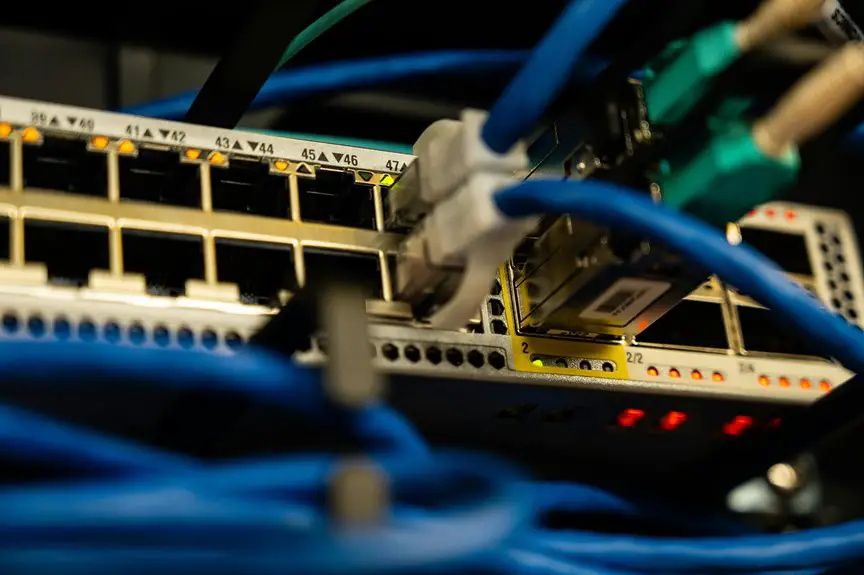To create an effective cable management plan for your office, start by assessing your current cables and identifying any tangles or damage. Choose the right tools like cable clips, sleeves, and trays to secure and hide cords. Implement organization techniques by grouping cables by function and labeling them for easy identification. Regularly maintain your setup to ensure longevity and prevent issues. If you want to explore more tips and techniques, keep going!
Table of Contents
Key Takeaways
- Assess your current cable situation by identifying all cables, their purposes, and checking for damage or tangling.
- Choose appropriate cable management tools like clips, sleeves, and trays to organize and conceal cables effectively.
- Group cables by function and use ties or Velcro straps for bundling, ensuring easy access and identification with labels.
- Regularly inspect and maintain cables, keeping them clean and avoiding outlet overload to prolong their lifespan.
- Future-proof your setup by selecting adjustable management solutions and leaving extra slack in cables for flexibility with new devices.
Assessing Your Current Cable Situation
To effectively manage cables in your office, start by assessing your current cable situation. Look around your workspace and identify all the cables you have. Check for tangled cords, unused cables, and those that are frayed or damaged.
Make a list of what you see, noting where each cable runs and what it connects to. Consider the purpose of each cable and whether it's still necessary for your setup. This assessment will help you determine which cables you can eliminate, replace, or reorganize.
Take note of how many devices need power or data connections, too. Understanding your current situation is the first step toward an organized and efficient cable management plan that improves your workspace's functionality and aesthetics.
Choosing the Right Cable Management Tools
How can you ensure your cables stay organized and accessible? Start by selecting the right cable management tools.
Consider using cable clips to secure cables along walls or desks, preventing them from tangling. Cable sleeves are fantastic for bundling multiple cords together, giving a neat appearance while protecting them from damage.
Using cable clips and sleeves can keep your workspace tidy, preventing tangles and protecting your cords.
For larger setups, cable trays or raceways can hide cables under or along desks, keeping your workspace clean. Velcro straps are adjustable and reusable, making them ideal for easily changing configurations.
Don't forget about labels; marking each cable helps you identify them quickly. By choosing the right tools, you'll create a more efficient and visually appealing office environment.
Implementing Cable Organization Techniques
Implementing effective cable organization techniques can transform your workspace into a more functional and tidy environment.
Start by grouping cables based on their function, such as power cords, data cables, and peripherals. Use cable ties or Velcro straps to bundle them together, reducing clutter and preventing tangling. Label each cable to easily identify its purpose, saving you time during setup or troubleshooting.
Consider using cable management trays or sleeves to conceal and protect cables beneath your desk. For longer runs, invest in cable raceways that can be mounted along walls.
Lastly, regularly assess your setup to adapt to any changes in equipment or layout. Keeping your cables organized not only enhances aesthetics but also promotes productivity and efficiency in your workspace.
Creating a Maintenance Plan for Longevity
While organizing your cables is crucial, creating a maintenance plan ensures their longevity and optimal performance.
Regularly inspect your cables for wear and tear. Look for frays, kinks, or discoloration that may indicate damage. Keep your cables clean and dust-free, as dirt and debris can affect their efficiency.
Schedule periodic checks, perhaps quarterly, to catch any issues early and replace damaged cables promptly. Additionally, avoid overloading outlets, which can lead to overheating.
Store any unused cables properly—coiled and secured to prevent tangling. By taking these proactive steps, you'll not only extend the life of your cables but also maintain a tidy workspace.
A solid maintenance plan keeps your office running smoothly and efficiently.
Tips for Future-Proofing Your Cable Management System
To ensure your cable management system can adapt to changing technology, start by selecting versatile solutions that accommodate future upgrades.
Use adjustable cable trays and raceways to easily modify layouts as needed. Opt for modular connectors that support various devices and standards, allowing you to swap components without a complete overhaul.
Incorporate labeling systems for easy identification and troubleshooting, which simplifies future adjustments. Keep extra slack in your cables to provide flexibility for re-routing or adding new devices.
Finally, consider planning for emerging technologies by leaving space for additional ports and connections. By making these strategic choices now, you'll create a cable management system that evolves with your office's needs, saving you time and effort down the line.
Frequently Asked Questions
How Often Should I Reassess My Cable Management Plan?
You should reassess your cable management plan regularly, ideally every six months or whenever you make significant changes to your setup. This ensures everything remains organized, functional, and safe, preventing potential issues down the line.
Can I Use Cable Management Tools for Home Offices?
Absolutely, you can use cable management tools for your home office. These tools help organize and conceal cables, making your workspace look neater and more efficient. It's a great way to enhance productivity and aesthetics.
What Are the Environmental Impacts of Cable Disposal?
When you dispose of cables improperly, they can release harmful chemicals into the environment. This contributes to pollution and waste. Recycling helps reduce these impacts, so consider proper disposal methods to protect the planet.
Are There Specific Regulations for Cable Management in Commercial Spaces?
Yes, there are specific regulations for cable management in commercial spaces. You must comply with local building codes and safety standards, ensuring cables are organized, accessible, and safe to prevent hazards and facilitate maintenance.
How Can I Involve My Team in the Cable Management Process?
Involving your team in the process is key. Encourage brainstorming sessions, assign roles based on strengths, and gather feedback. This collaboration fosters ownership, ensuring everyone feels invested in achieving a tidy and efficient workspace together.




